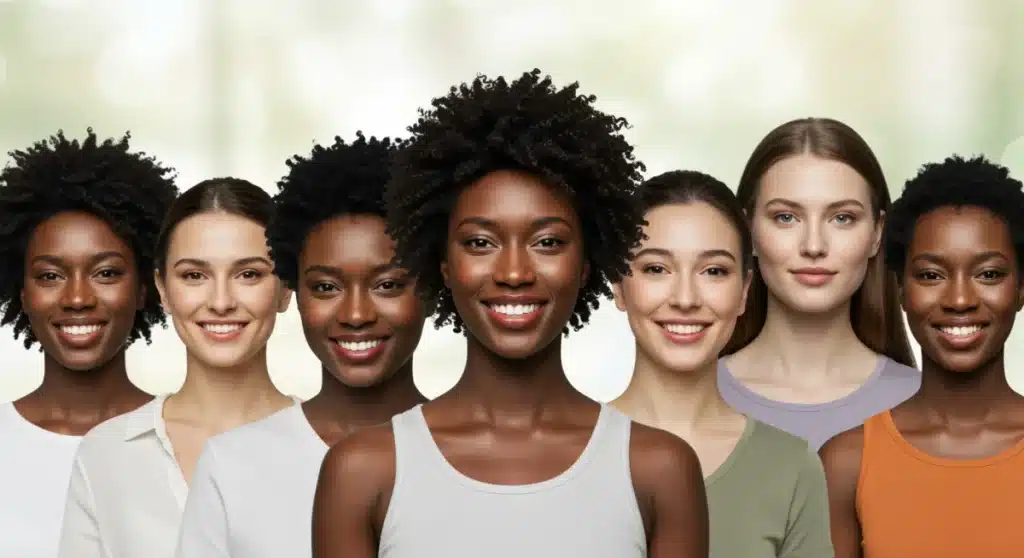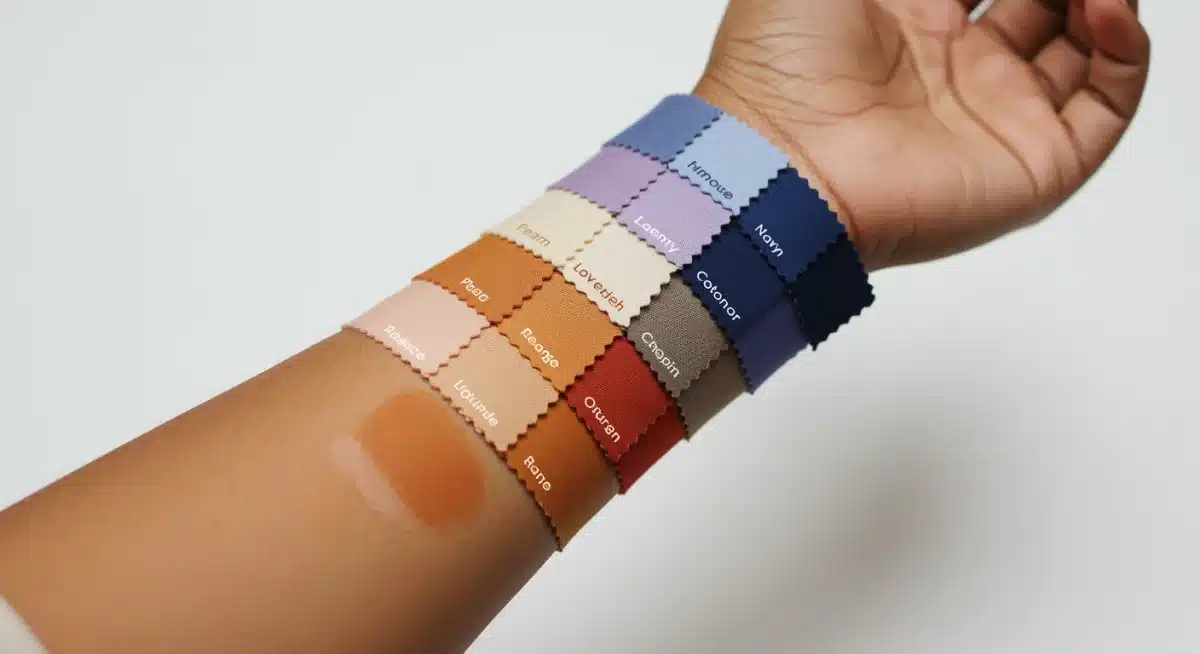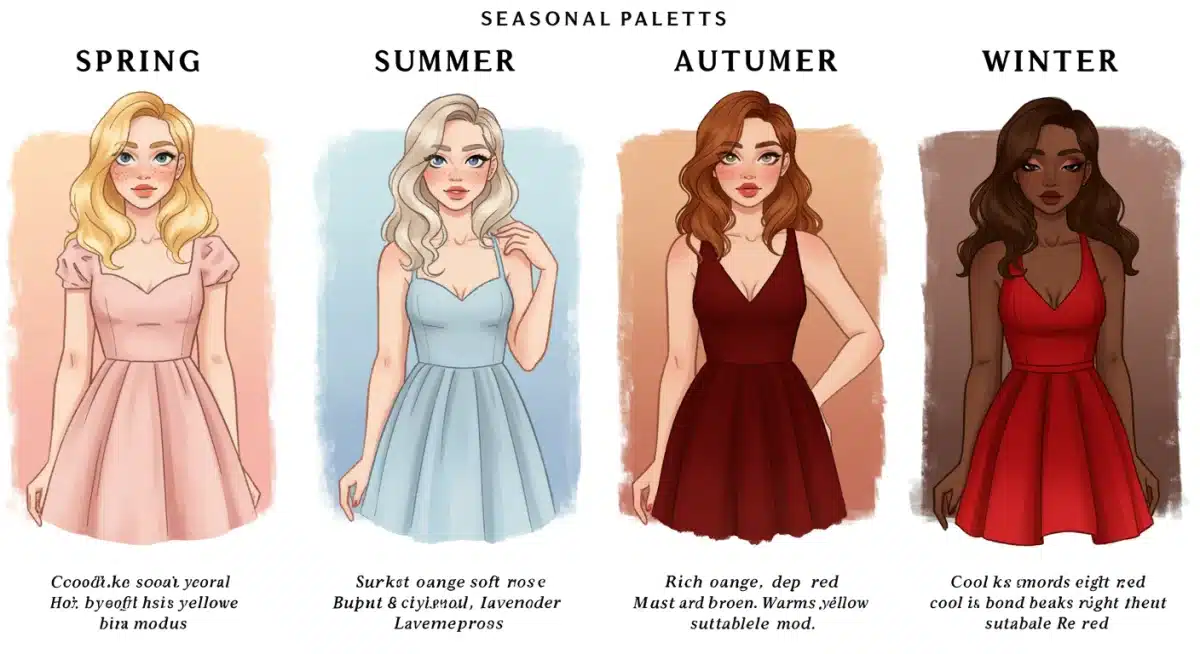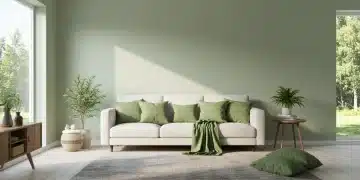Color Analysis: Best Colors for Your Skin Tone in 2025

Advertisement
Color analysis is a transformative process that identifies the most flattering hues for an individual’s unique skin tone, ensuring a harmonious and radiant appearance in clothing, makeup, and accessories.
Welcome to the transformative world of color analysis skin tone, where understanding your unique complexion unlocks a palette of possibilities to enhance your natural beauty. In 2025, more than ever, personal style is about authenticity and confidence, and knowing which colors truly complement you can revolutionize your wardrobe and makeup choices. This guide will walk you through the art and science of finding your perfect shades.
Understanding the Basics of Color Analysis
Color analysis is a method used to determine the colors of clothing and makeup that best suit an individual’s natural coloring. This process typically involves identifying your skin’s undertone, which is the subtle hue beneath the surface of your skin. Getting this right is the foundation upon which all other color decisions are built, ensuring that your choices enhance rather than detract from your appearance.
Advertisement
The core concept revolves around the idea that certain colors will make your skin look more vibrant, your eyes brighter, and your features more defined, while others might wash you out or make you appear tired. This isn’t about rigid rules, but rather about understanding harmony and contrast to make informed decisions that celebrate your individuality.
Identifying Your Skin’s Undertone
Before diving into seasonal palettes, pinpointing your skin’s undertone is crucial. This is often the most challenging yet vital step in the entire color analysis process. There are generally three main undertones:
- Warm: Skin has golden, peach, or yellow hues. Veins often appear greenish.
- Cool: Skin has pink, red, or blue hues. Veins often appear bluish or purple.
- Neutral: A mix of warm and cool, or neither appears dominant. Veins might appear a mix of blue and green.
A simple way to test your undertone is to look at the veins on your wrist under natural light. If they look green, you likely have warm undertones. If they look blue or purple, you’re probably cool-toned. If you see a mix or can’t quite tell, you might be neutral. This initial assessment sets the stage for a more detailed color journey, guiding you towards the families of colors that will make you shine.
Advertisement
Understanding your undertone helps you move beyond superficial color preferences and into a realm where your choices actively enhance your natural glow. It’s a key first step in mastering your personal color palette and will serve as a reliable guide for all your future style decisions.
The Four Seasonal Color Palettes Explained
Once your undertone is identified, the next step in color analysis skin tone is often categorizing your coloring into one of the four traditional seasons: Spring, Summer, Autumn, or Winter. Each season represents a distinct palette of colors that harmonize with specific combinations of skin tone, hair color, and eye color. This framework provides a comprehensive guide for selecting clothing, accessories, and makeup.
These seasonal classifications are not about the time of year you were born, but rather the overall impression of your natural coloring. Think of a Spring day with its fresh, clear hues, or a Winter landscape with its stark contrasts. These natural inspirations translate directly into the characteristics of each color palette, offering a visual roadmap for your style.
Spring: Bright and Warm
Spring types typically have warm undertones, often with clear, bright eyes and hair that may have golden or reddish highlights. Their best colors are:
- Clear, bright warm colors like peach, coral, light greens, and golden yellows.
- Colors that reflect the freshness and vibrancy of springtime.
- Avoid dull, heavy, or overly dark colors that can overwhelm their delicate complexion.
These individuals radiate a youthful energy, and their ideal palette supports this by emphasizing clarity and warmth. Think of the first blooms of spring and the gentle sunshine; these are the colors that will bring a Spring type to life.
Summer: Soft and Cool
Summer individuals have cool undertones, often with soft, muted hair and eyes. Their skin may have a rosy or cool beige hue. Their ideal colors are:
- Soft, muted cool colors such as dusty rose, periwinkle blue, lavender, and soft grays.
- Colors that evoke a hazy, tranquil summer day.
- Steer clear of overly bright or intense colors that can overpower their gentle features.
The Summer palette is all about subtlety and elegance, reflecting a serene and refined aesthetic. These colors help Summer types appear sophisticated and calm, enhancing their natural softness without introducing harsh contrasts.

Autumn: Rich and Warm Earth Tones
Autumn types share warm undertones, but their overall coloring is richer and deeper than Spring. They often have golden or reddish-brown hair, warm eye colors, and a complexion with a golden or olive glow. The best colors for Autumn individuals are:
- Deep, earthy warm tones like olive green, rust, mustard yellow, and deep teal.
- Colors that mirror the vibrant and sophisticated hues of autumn foliage.
- Bright, cool, or very light pastel colors tend to wash them out.
The Autumn palette is characterized by its grounded and luxurious feel, drawing inspiration from the bountiful harvest season. These colors bring out the natural warmth and depth in an Autumn individual, creating a harmonious and striking appearance that feels both natural and opulent.
Choosing the right shades within this palette can dramatically enhance an Autumn type’s natural warmth, making their skin glow and their eyes sparkle. This season embodies a sophisticated earthiness that is both inviting and strong, perfect for those with a naturally rich complexion.
Winter: Bold and Cool Contrasts
Winter types have cool undertones, often with strong contrasts in their natural coloring, such as dark hair and light eyes, or very fair skin and dark hair. Their skin may have a cool beige, olive, or porcelain hue. Their ideal colors are:
- Clear, intense cool colors like true red, royal blue, emerald green, and stark black or white.
- Colors that reflect the crisp, dramatic landscape of winter.
- Soft, muted, or overly warm colors should generally be avoided as they can appear dull against a Winter’s vivid complexion.
The Winter palette is all about drama and clarity, emphasizing strong contrasts and vibrant hues. These colors highlight a Winter individual’s inherent intensity and striking features, creating a powerful and sophisticated look. Think of the sharp, clear lines and bold colors found in a winter wonderland; these are the shades that allow a Winter type to truly stand out with confidence and elegance, making a memorable visual impact.
Beyond the Four Seasons: Sub-Seasons and Advanced Color Analysis
While the four main seasonal categories provide an excellent starting point for color analysis skin tone, the world of personal color is far more nuanced. Advanced systems delve into sub-seasons, offering even more precise palettes. These sub-seasons recognize that not everyone fits perfectly into a broad category, allowing for a more tailored and accurate assessment of an individual’s best colors. This level of detail helps to refine choices, ensuring every color worn is truly optimal.
The concept of sub-seasons addresses the variations within each main season, considering factors like depth (light vs. deep), clarity (clear vs. muted), and warmth/coolness. For instance, a ‘Soft Summer’ will have a slightly different palette than a ‘Cool Summer,’ even though both fall under the Summer umbrella. This fine-tuning is what makes advanced color analysis so powerful and personally relevant.
Exploring the Sub-Seasons
Each of the four main seasons typically has three sub-seasons, totaling twelve distinct categories. These variations are determined by which characteristic (warmth/coolness, depth, or clarity) is most dominant in an individual’s natural coloring. Understanding these nuances can seem complex at first, but it offers unparalleled accuracy in finding your perfect shades.
- True/Pure: When the primary characteristic of the season (e.g., warm for Spring, cool for Summer) is dominant.
- Flow: When an individual’s coloring leans towards an adjacent season, blending characteristics.
- Dominant Characteristic: When depth (light/deep) or chroma (clear/muted) is the most prominent feature.
For example, a ‘Deep Autumn’ would gravitate towards the darker, richer tones within the Autumn palette, while a ‘Light Spring’ would shine in lighter, more delicate shades of Spring. This detailed approach ensures that your color recommendations are perfectly aligned with your unique features, enhancing your natural beauty in the most effective way possible. It’s about perfecting the harmony between you and your wardrobe.
Embracing sub-seasons allows for a more personalized style journey, moving beyond generic advice to truly bespoke recommendations. This precision ensures that every garment, accessory, and makeup product you choose works in concert with your natural coloring, creating a cohesive and stunning look. It’s an investment in understanding yourself and presenting your best self to the world.
Practical Application: Building Your Color-Analyzed Wardrobe
Once you’ve identified your seasonal or sub-seasonal palette through color analysis skin tone, the exciting part begins: applying this knowledge to your wardrobe. This isn’t about throwing out everything you own, but rather strategically building a collection of clothing and accessories that consistently flatter your complexion. The goal is to create a cohesive and harmonious wardrobe that makes getting dressed effortless and enjoyable.
Building a color-analyzed wardrobe means making conscious choices about the colors you bring into your closet. Over time, you’ll find that your outfits feel more coordinated, and you’ll receive more compliments on how radiant you look. It’s a journey of refinement, leading to a closet full of pieces that truly serve your best interests.
Shopping with Your Palette in Mind
When shopping, keep your color palette handy, whether it’s a physical swatch fan or a digital guide on your phone. This will help you make informed decisions and avoid impulse buys that don’t align with your best colors. Focus on core pieces in your ideal neutrals and then add pops of your accent colors.
- Start with Neutrals: Identify the best neutral colors for your palette (e.g., true black for Winters, camel for Autumns, taupe for Summers).
- Incorporate Accent Colors: Gradually add pieces in your vibrant accent colors for visual interest and personality.
- Consider Fabric and Texture: Colors can appear differently on various fabrics. Pay attention to how a color looks on the specific material.
Remember that accessories, such as scarves, jewelry, and handbags, are also powerful tools to introduce your best colors. Even if a main clothing item isn’t perfectly in your palette, a well-chosen scarf or statement necklace in a flattering hue can bring harmony to the entire outfit. This thoughtful approach ensures every element contributes to your overall stunning appearance.
The process of curating a color-analyzed wardrobe is liberating. It simplifies decision-making, reduces shopping mistakes, and ensures that every item you own contributes to a polished and harmonious look. This strategic approach to fashion not only enhances your appearance but also boosts your confidence, making every day a chance to shine.
Makeup and Hair Color: Completing Your Color Harmony
The principles of color analysis skin tone extend far beyond clothing, playing a crucial role in selecting the most flattering makeup and hair colors. Just as with your wardrobe, aligning your beauty choices with your personal palette can dramatically enhance your features, making your skin appear more vibrant, your eyes more striking, and your overall look more cohesive. This holistic approach ensures every aspect of your appearance works in harmony.
Choosing the right makeup shades can illuminate your face, making you look refreshed and awake, while the wrong ones can make you appear tired or sallow. Similarly, a hair color that complements your undertone can brighten your complexion and make your eyes pop, whereas an ill-suited shade might do the opposite. It’s about achieving a seamless and natural enhancement.
Selecting Makeup for Your Palette
Your color season dictates the most flattering shades for your foundation, blush, eyeshadow, and lipstick. For example, cool-toned individuals will shine in pink-based foundations and berry lipsticks, while warm-toned individuals will look best in yellow-based foundations and coral or peach lipsticks.
- Foundation and Concealer: Match your undertone precisely to avoid a mask-like effect.
- Blush and Lipstick: Choose shades that echo the natural flush of your skin within your seasonal palette.
- Eyeshadow: Opt for colors that complement your eye color and overall palette, enhancing their natural sparkle.
Experimentation is key, but always with your determined palette as a guide. Don’t be afraid to try new shades within your recommended range, as even subtle shifts can make a big difference. The right makeup enhances your natural beauty without overpowering it, creating a polished and harmonious finish that feels authentically you. This tailored approach to beauty ensures you always look your best.
Choosing the Right Hair Color
Hair color is another significant element affected by color analysis. A hair color that works with your undertone and seasonal palette will look natural and enhance your complexion. For example, a cool-toned person might look best with ashier browns or platinum blondes, while a warm-toned person might suit golden blondes or rich auburns.
Avoid colors that clash with your undertone, even if they are trendy, as they can drain color from your face or make your skin appear dull. Consulting with a stylist who understands color theory can be incredibly beneficial in finding the perfect shade that illuminates your features and brings out your natural radiance. The goal is to select a hair color that feels like an extension of your natural beauty, not a stark contrast.

The Evolution of Color Analysis: Trends for 2025
As we move into 2025, the field of color analysis skin tone continues to evolve, embracing new technologies and a more inclusive approach to personal styling. While the foundational principles remain constant, trends are emerging that make color analysis more accessible, personalized, and relevant for a diverse global audience. These advancements are aimed at making the process less intimidating and more empowering for everyone.
The focus is shifting from rigid adherence to strict seasonal rules to a more flexible interpretation, encouraging individuals to understand their core palette while also exploring colors that might be traditionally outside their season but still work well. This modern approach emphasizes personal expression and confidence, rather than just strict categorization.
Technological Advancements in Color Analysis
Digital tools and AI are beginning to play a more significant role in color analysis. Apps and online platforms can now offer preliminary assessments based on uploaded photos, providing instant feedback on potential seasonal palettes. While not a replacement for professional analysis, these tools serve as excellent starting points, making the concept more approachable for a wider audience.
- AI-Powered Tools: Utilize algorithms to analyze skin, hair, and eye color for initial palette suggestions.
- Virtual Try-On: Experiment with different clothing and makeup colors virtually before making purchases.
- Personalized Recommendations: Receive tailored style advice based on detailed color profiles.
These technological aids democratize color analysis, allowing more people to engage with the concepts and begin their journey towards discovering their best colors. The convenience and instant feedback provided by these tools are transforming how individuals approach personal styling, making it an exciting time for anyone interested in enhancing their appearance.
Inclusivity and Personalization
The beauty and fashion industries are increasingly recognizing the importance of inclusivity, and color analysis is following suit. There’s a growing emphasis on developing palettes that cater to a broader spectrum of skin tones and ethnic backgrounds, moving beyond historically Eurocentric classifications. This ensures that everyone can find their perfect colors, regardless of their heritage.
Furthermore, the trend towards personalization means that even within a specific palette, there’s room for individual preference and adaptation. It’s about empowering individuals to use color analysis as a guide, not a strict rulebook, allowing for creativity and self-expression. This evolving approach celebrates the unique beauty of every individual, making color analysis a truly empowering tool for personal style in 2025 and beyond.
Maintaining Your Color Harmony and Adapting Over Time
Discovering your ideal color palette through color analysis skin tone is a significant step, but maintaining that harmony and adapting it over time is equally important. Our natural coloring can subtly change due to factors like age, sun exposure, or even significant hair color changes. Regularly reassessing your palette ensures that your style continues to flatter you, keeping your look fresh and relevant. It’s a dynamic process, not a one-time fix.
Life is about evolution, and so is personal style. What suited you perfectly in your twenties might need a slight adjustment in your forties or fifties. Being aware of these potential shifts and knowing how to adapt your color choices will keep your appearance consistently polished and confident, no matter what changes life brings.
Periodic Reassessment of Your Palette
It’s a good practice to revisit your color analysis every few years or if you notice significant changes in your appearance. This could involve:
- Changes in Hair Color: Especially if you’ve gone from a natural shade to a dramatically different one.
- Skin Tone Variations: Due to aging, sun exposure, or changes in health.
- Evolving Personal Style: Your preferences and confidence in certain colors might shift.
A professional color analyst can help you fine-tune your palette, perhaps shifting you from a ‘True Summer’ to a ‘Soft Summer,’ or incorporating new accent colors that now complement your evolving look. This periodic check-up ensures that your wardrobe and makeup choices remain optimally flattering, reflecting your current self with precision and elegance. It’s an ongoing commitment to looking and feeling your best.
Adapting to Life’s Changes
As we age, our skin tone can become softer, and the contrast in our features might lessen. This often means that very harsh or extremely bright colors that once suited us perfectly may now feel too strong. Adapting might involve leaning into softer versions of your original palette or exploring adjacent sub-seasons that feature more muted tones.
For example, a ‘True Winter’ might find that as they age, ‘Cool Summer’ shades become more harmonious, offering a softer yet still flattering alternative. The key is to remain flexible and open to slight adjustments, always keeping your underlying undertone in mind. This adaptability ensures that your color choices continue to enhance your natural beauty through every stage of life, allowing you to age gracefully and stylishly.
Ultimately, color analysis is a tool for empowerment. It provides the knowledge to make confident style choices that celebrate your unique self. By understanding and adapting your personal color harmony, you ensure that every color you wear contributes to a radiant, authentic, and timeless presentation of who you are.
| Key Aspect | Brief Description |
|---|---|
| Skin Undertone | Identifies the subtle hue beneath skin (warm, cool, neutral) for foundational color matching. |
| Seasonal Palettes | Categorizes individuals into Spring, Summer, Autumn, or Winter based on overall coloring. |
| Wardrobe Application | Guides selection of clothing and accessories to build a cohesive, flattering closet. |
| Makeup & Hair | Extends color principles to beauty choices for a harmonious and enhanced appearance. |
Frequently Asked Questions About Color Analysis
Color analysis is a method to determine which colors best complement your natural skin tone, hair, and eye color. It’s important because wearing your ideal colors can make your complexion appear brighter, reduce the look of blemishes, and make your eyes sparkle, enhancing your overall appearance and confidence.
You can determine your skin’s undertone by checking the color of the veins on your wrist under natural light. If they appear green, you likely have warm undertones. If they look blue or purple, you’re probably cool-toned. A mix or difficulty in distinguishing suggests a neutral undertone.
While your core undertone usually remains constant, significant changes like hair color, aging, or prolonged sun exposure can subtly alter how colors interact with your skin. A re-analysis every few years or after major changes can ensure your palette remains optimally flattering.
Color analysis is a guide, not a strict rulebook. If you love a color outside your palette, try wearing it away from your face, perhaps in pants, skirts, or accessories. You can also look for a shade of that color that has a warmer or cooler undertone to better suit your complexion.
For makeup, choose foundation and concealer that match your undertone. Select blush and lipstick shades that echo the natural flush of your skin within your seasonal palette. Eyeshadows should complement your eye color and overall palette, enhancing your features without clashing.
Conclusion
Embracing the principles of color analysis is a journey toward self-discovery and enhanced personal style. By understanding how colors interact with your unique skin tone, you gain the power to make intentional choices that highlight your natural beauty and boost your confidence. Whether you identify with a broad seasonal palette or delve into the nuances of sub-seasons, the goal remains the same: to create a harmonious and authentic visual presentation. In 2025, with evolving trends and technological advancements, color analysis remains an invaluable tool for anyone looking to refine their aesthetic and truly shine.





